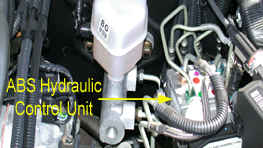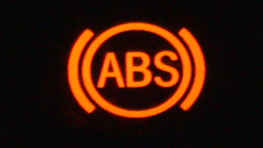
Description: Today, virtually all cars come with ABS as standard equipment or as an option. The typical ABS system includes wheel-speed sensors, a hydraulic control unit, and an electronic control unit. When you apply the brake pedal, the electronic control unit monitors and compares the signals from the wheel-speed sensors. If the electronic control unit senses rapid deceleration (impending lock-up) at a given wheel, the electronic control unit commands the hydraulic control unit to reduce hydraulic pressure to that wheel. This type of pressure limiting is similar to pumping the brake pedal, only much faster. Some pick-up trucks and cargo vans have rear-wheel only ABS to handle different braking needs under different loading conditions. This type of ABS system controls only the rear wheels and limits pressure to both of them when either is about to lock.
Purpose: ABS was designed to help you maintain directional control during emergency stops and when road conditions are poor. By maintaining control, you have better chances of avoiding a crash. ABS is especially useful on wet and slippery roads. You should never pump the brake pedal on a car with ABS, since the system itself “pumps” the brakes automatically. All you need to do is apply firm and continuous pressure to the brake pedal to activate ABS operation. When the ABS system operates, you may feel a pulsating sensation from the brake pedal. When ABS operation is no longer needed, the braking system reverts to conventional hydraulic operation without intervention from the ABS system.
Maintenance Tips/Suggestions: When turning the ignition switch to the on position, the amber BRAKE, ANTILOCK or ABS light on the instrument panel should glow momentarily, and then turn off. If the light stays on or flashes, or comes on while driving, it indicates a fault in the ABS system. Have your car’s ABS system inspected immediately by a professional technician to determine the source of the problem. Your owner’s manual may specify periodic flushing and filling of the brake hydraulic system, which should not be overlooked. This is a service best left to professional technicians, as many cars with ABS have specialized brake-bleeding procedures. Braking systems with ABS can also generate extremely high hydraulic pressures, which can be dangerous. Once again, consult a professional service technician if your car needs ABS or hydraulic system service.

Description: Located on the instrument panel, this warning light may be labeled BRAKE, ANTILOCK or ABS.
Purpose: The ABS warning light alerts you to problems in the ABS system.
Maintenance Tips/Suggestions: When turning the ignition switch to the on position, the amber BRAKE, ANTILOCK or ABS light on the instrument panel should glow momentarily, and then turn off. If the light stays on or flashes, or comes on while driving, it indicates a fault in the ABS system. Have your car's ABS system inspected immediately by a professional technician to determine the source of the problem.

